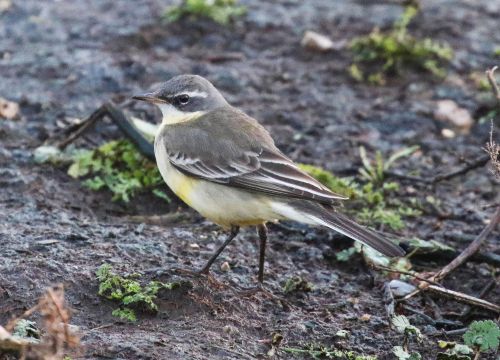After I left it a little too late to connect with East Anglia’s previous long staying Eastern Yellow Wagtail last November, I expected it would not be too long before I recorded this new species. In the event the opportunity came quite soon when another individual arrived on farmland near Snettisham just before Christmas, but again I waited until there could be two or more targets for any day trip I might make.

Blue-headed Eastern Yellow Wagtail © and courtesy of Ewan Urquhart
The bird I most want to see in Norfolk this winter is a Lesser White-Fronted Goose that was first reported on 21st November and has ranged widely whilst remaining elusive ever since. Only twice has that huge potential lifer been observed for longer in one place than it would take to drive there. The first time it was flushed before dusk but two days ago on 9th January it was still present at nightfall at a location to the west of King’s Lynn (see here).
Things at last seemed right to make a dawn start at the Goose site on my way to trying for the EYW. And so it was that at just after 8:00 am I arrived at what looked to be a rather muddy and unpromising field near the village of Walpole St Andrew. Just five birders were staking things out but there were no Geese on the ground. Over the next 30 minutes several skeins of Pink-footed Geese flew in, circled around and moved on. The consensus amongst the other birders was that with overnight rain the preferred grazing site of a day earlier was now too wet for the possible LWFG carrier flocks’ liking.
After those birders all gave up and left I too moved on to rendezvous with Ewan at the EYW site. The individual is of a sub-species within the new taxon (nominate form tschutchenshis) that is variously referred to as Blue-headed or Alaskan Eastern Yellow Wagtail. The preceding sentence possibly indicates just how complex the entire Yellow Wagtail taxon has now become (see here). Today’s bird, a first year male has remained faithful to some manure piles along a farm track at TF714380.
Ewan had been there since first light (see here) and already observed the bird very well. But it had not been seen since for over an hour and between 20 and 30 birders were now waiting patiently for it’s re-appearance. After another 30 minutes or so our quest flew in again to a muddy field across the track from the manure piles (pictured above) and all of us were soon satisfied. The EYW then relocated to it’s more usual spot and many more pictures were taken, but in the poor light my own efforts (below) might best be termed record shots. This was certainly a rather striking looking bird. My thanks are due to Ewan for kindly allowing me to use his pictures in this post.
After a late breakfast at a beach café in nearby Heacham we went our separate ways. The LWF Goose not having been relocated, I tried for and dipped eight Smew at the developing RSPB / Hanson Ouse Fen NR (see here) near St Ives, while Ewan had priorities of his own. When complete, the very impressive Ouse Fen will be the largest reed bed anywhere in the UK, if presently very difficult to locate Smew in. Exploring the place today I appreciated the massive potential it has, and once again what incredible habitat creation work the RSPB carries out with projects such as this and Wallasea Island. But as ever I baulk at the mass market populism that is deemed necessary to sustain it all.
Mild winters such as we are presently experiencing mean Smew are less likely to occupy the far western reaches of their winter range that the British Isles represent. This has so far been a poor season for the iconic Sawbill that I devoted some time and effort to a year ago, and unless there is a cold snap that looks set to continue. For an interesting assessment of the current national status of wintering Smew see here. Meanwhile a latest national photographic competition over one bird continues to emanate from Whipsnade Zoo, and my own previous post is one of the quickest ever to pass 100 referrals.
This is just a brief treatment of today’s EYW, since many birders have seen and blogged it already and I prefer if possible to add something to what has been published already on the wildlife presented in this journal. But Eastern Yellow Wagtail is my second bird lists addition of the new year, following last week’s announcement that Hudsonian Whimbrel has been reinstated as a full species by the International Ornithological Congress (IOC) and hence the BOURC (see here). So my British list now stands at 354 and my WestPal list 496.





